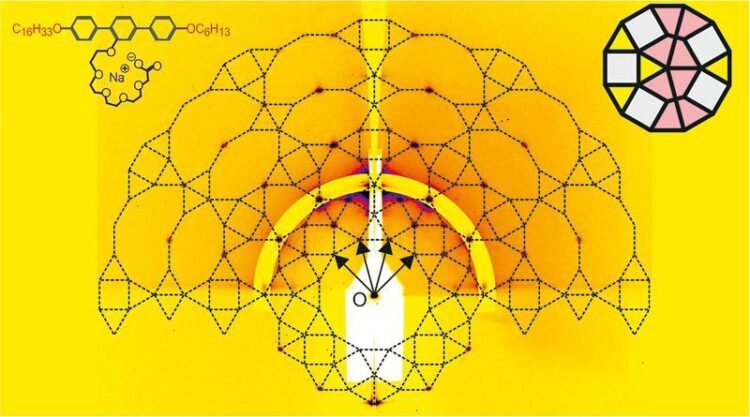Researchers discover liquid quasicrystal with dodecagonal tiling pattern

Illustration of liquid quasicrystals consisting of dodecagons
(c) Zeng et al / Nature Chemistry
An unusual quasicrystal has been discovered by a team from the Martin Luther University Halle-Wittenberg (MLU), the University of Sheffield and Xi’an Jiaotong University. It has a dodecagonal honeycomb structure that has never been seen before. Until now, similar quasicrystals were only known to come in a solid – not liquid – form. The team presents its results in the scientific journal “Nature Chemistry”.
Quasicrystals have a special structure. They have a regular pattern similar to normal crystals, however, in normal crystals, the arrangement of the individual components is repeated over and over at regular intervals. In the case of quasicrystals, the components do not fit together in such a periodic pattern. This special structure gives them special properties that normal crystals do not have.
The newly discovered quasicrystal consists of dodecagons, which in turn are made up of a mixture of triangular, square and, for the first time, trapezoidal shaped cells. These are generated from the self-assembly of “T-shaped” molecules. “We have discovered a perfectly ordered liquid quasicrystal. Such a material has never been seen before,” says chemist Professor Carsten Tschierske at MLU. The team’s latest study also provides new insights into the formation of these special structures. “Until now, it was assumed that the stability of quasicrystals was based on an entropy gain resulting from the breaking of strict periodic tessellation rules. However, our results suggest that, in this case, the stability may be due to energy minimisation in the perfect quasicrystalline order,” Tschierske adds.
According to the researcher, the potential applications for these new liquid quasicrystals are promising. For example, they could be used in the future to produce functional self-assembling and self-healing materials which could be applied in optics and electronics, as they have the potential to create new ways to manipulate light and charge carriers.
Parts of the work were funded by the German Research Foundation within the framework of the Research Training Group 2670 “Beyond Amphiphilicity: Self-Organization of Soft Matter via Multiple Noncovalent Interactions”.
Originalpublikation:
Study: X. Zeng et al. A columnar liquid quasicrystal with a honeycomb structure that consists of triangular, square and trapezoidal cells. Nature Chemistry (2023). doi: 10.1038/s41557-023-01166-5
https://doi.org/10.1038/s41557-023-01166-5
Media Contact
All latest news from the category: Life Sciences and Chemistry
Articles and reports from the Life Sciences and chemistry area deal with applied and basic research into modern biology, chemistry and human medicine.
Valuable information can be found on a range of life sciences fields including bacteriology, biochemistry, bionics, bioinformatics, biophysics, biotechnology, genetics, geobotany, human biology, marine biology, microbiology, molecular biology, cellular biology, zoology, bioinorganic chemistry, microchemistry and environmental chemistry.
Newest articles

NASA: Mystery of life’s handedness deepens
The mystery of why life uses molecules with specific orientations has deepened with a NASA-funded discovery that RNA — a key molecule thought to have potentially held the instructions for…

What are the effects of historic lithium mining on water quality?
Study reveals low levels of common contaminants but high levels of other elements in waters associated with an abandoned lithium mine. Lithium ore and mining waste from a historic lithium…

Quantum-inspired design boosts efficiency of heat-to-electricity conversion
Rice engineers take unconventional route to improving thermophotovoltaic systems. Researchers at Rice University have found a new way to improve a key element of thermophotovoltaic (TPV) systems, which convert heat…



